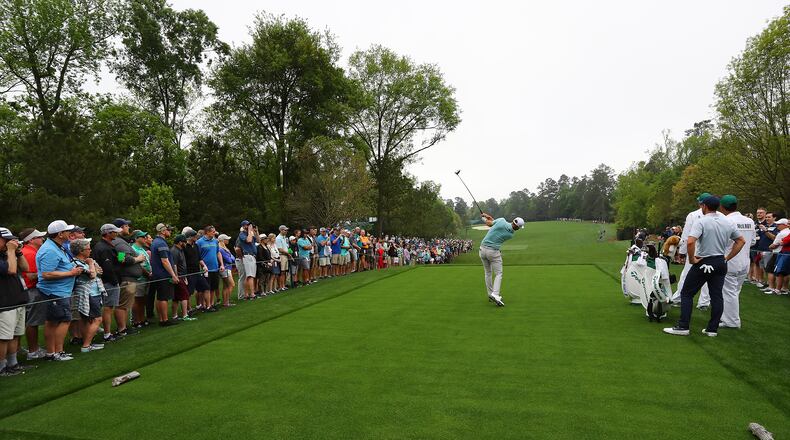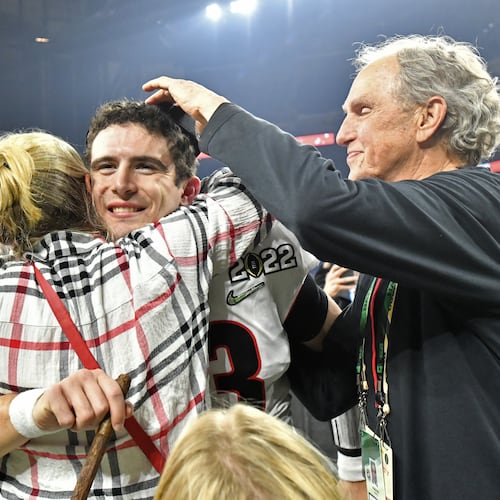Where’s Herbert Warren Wind when you need him?
It was the Homer of golf writers who in 1958 wrote about the action “down in the Amen Corner where Rae’s Creek intersects the 13th fairway near the tee, then parallels the front end of the green on the short 12th and finally swirls alongside the 11th green.” And just like that, almost off-handedly, this sequence of holes was gifted the last thing it needed to gain renown — a catchy, evocative name. Amen Corner was born.
There is another corner of the course opposite that far reach of Augusta National that is in line for a good nicknaming. Something suggestive of mayhem and exasperation.
» Course history: Hole-by-hole look at Augusta National
It will never happen, mind you, for several reasons. For one, Mr. Wind and his elegant ilk are no longer with us. I certainly can’t come up with anything eternal. For another, holes No. 4-5-6 fall far too early to be a part of the Sunday Masters crescendo. So much happens on that back nine that all else gets kind of washed over.
That’s too bad because, with the recent lengthening of the par-4 5th hole — heretofore the most overlooked hole on the property — this corner just may be the most trying stretch of holes in all the green sausage grinder that is Augusta National.
With the money to reshape the land to any whim, the lords of the Masters decided this year to add another 40 yards to an already toothy fifth. And if that doesn’t suit them, one day they will just buy up a stretch of I-20 and put a tee box in the median.
The result is a now 495-yard par 4 that has grabbed the players’ attention before the first competitive shot is struck.
“Between there and 11, I may even consider No. 5 a more difficult hole now,” Jordan Spieth said. “I would have said 11 is the toughest hole on the course prior to the new No. 5.”
"I'm struggling a little bit right now on how to play the hole, so I'll have to figure that out over the next couple days." That's Jordan Spieth speaking, the guy who rolls out of bed and finishes top-five in this tournament.
Having already let out the par-3 4th hole — to where it can play 240 yards to a roller-coaster green – the guardians of par have created quite a little gauntlet here with the lengthening of No. 5. Throw in the par-3 sixth, with a green that practically requires an escalator to get from one level to the next, and these people have almost succeeded in turning golf into actual, honest work.
Phil Mickelson throws the 450-yard par-4 seventh hole into the mix, too. "I think 4-5-6-7 is a very difficult four‑hole stretch and making a little bit harder I think is a good thing," he said. "I always like making hard holes harder and I think guys that are playing well will be able to make par (on No. 5) and pick up a quarter or half a stroke on the field that are not able to make par. Ultimately, that's a good thing."
» Masters tee times: First-, second-round pairings
During last year’s Masters, Nos. 4-5-6 played as the second-, sixth- and eighth-hardest holes. In contrast, Amen Corner presented both the most difficult (the 505-yard par-4 11th) and least difficult (the 510-yard par-5 13th). No. 12, the famed par 3 over Rae’s Creek was right in the middle, the ninth hardest. So, which stretch is really more deserving a prayerful nickname?
In the redesign of No. 5, they also moved back the complex of large, deep fairway bunkers on the left side, and created a stiffer penalty for finding them.
"I think they are unplayable to get the ball to the green," Tiger Woods said. "You have to be very lucky and get a situation that you might be able to get to the front edge of the green. But you need to stay out of those bunkers."
Even a good and true drive leaves no bargain.
“I hit a good drive (Monday), and the course was playing really soft and a bit long. And I hit 5‑iron in,” Tommy Fleetwood said. “A good drive last year – if you could be aggressive with the driver – you might have a wedge or 9‑iron to that middle part of the green. It wasn’t a difficult shot.”
In summarizing the change to No. 5 — a hole due entirely new respect now — two-time Masters champion Ben Crenshaw was succinct, simply calling it “a monster.”
While the knights of the keyboard may fail to come up with a catchy name for this other critical corner of Augusta National, players undoubtedly will come up with a few of their own. They will not be flowery, or even fit for general consumption.
About the Author
The Latest
Featured


